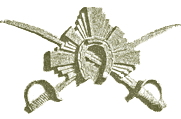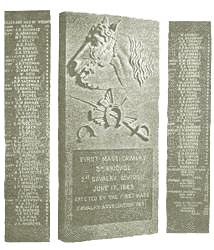
In
Remembrance of Their Comrades at the Battle of Aldie
The
1st Massachusetts Cavalry Dedicates a Monument in 1891
The following
is an excerpt from the book A History of the First
Regiment of Massachusetts Cavalry Volunteers by Benjamin
W. Crowninshield, Major First Massachusetts Cavalry and
Brevet Colonel U.S.V. This excerpt includes the 1891
address given by Charles Davis to former members of the
1st Massachusetts Cavalry in dedication of a monument to
their fallen comrades at the Battle of Aldie, June 17,
1863. More about the 1st Massachusetts Cavalry at this
battle can be found in the article: "Henry Lee Higginson and the 1st
Massachusetts Cavalry at the Battle of Aldie.")

The
ceremonies at the monument were short and impressive, and
a fitting commemoration of the twenty-eighth anniversary
of this bloody contest, the history of which is best told
by Major Charles Davis, who briefly spoke as follows:

"Beneath
a sky as blue as the field on the glorious flag that
floats proudly over a free, united, and prosperous
country, we are assembled to dedicate this monument
erected to commemorate an event in the history of the
nation. When I gaze into the faces of my comrades in
arms, when I look back nearly a third of a century; when
I recall the incidents of the camp, the march, the
bivouac, and the battle, a feeling indescribably tender
gathers around my heart as I think of the gallant fellows
that, with us, under the red, white, and blue banner of
the Union; rode side by side, and followed the guidon of
the 1st Massachusetts Cavalry. Those were the days when
experience and hard service made us men of ideas.
"We learned to make three days' rations last six
days; that is, to sparingly eat one hardtack, and, aided
by cold water, imagine we had eaten two. We also learned
how to kill a pig within hearing of the provost guard
without letting it squeal... We also learned to endure
fatigue and hunger, to suffer from heat and cold, to face
danger and even death, not for gain or glory, but to
up-hold the flag and preserve the Union.
"Twenty-eight years ago to-day, in the afternoon, on
this field of Aldie, the Union forces under Kilpatrick
met the Confederate forces under Stuart.
"It was strictly a cavalry battle, probably the
hottest fight of the war. No such encounter, no such
daring bravery, had before been exhibited by the cavalry
of either army. The fire was murderous, the charges and
counter-charges were superb and grand. The 1st
Massachusetts Cavalry fought as brave men could fight to
stem the tide that bore them back, until the whole right
gave way upon this bloody field where many a loved
comrade met a soldier's death.
"Of the 294 comrades, representing eight companies
of the regiment engaged in the action, our loss was 198.
"I do not propose to recall the scenes of excitement
of that day. This monument bears upon its panels a roll
of honor that will be read by future generations, and
teach lessons of patriotism and reverence for the flag to
the youth of America when we are forgotten. Neither do I,
at this time, propose to recall the daring deeds and acts
of bravery on Aldie and other fields, for the brilliant
record of the 1st Massachusetts Cavalry will soon appear
in its regimental history, and every living comrade may
then live over again the days of his campaigns; but I
will read an extract from the official report of our
beloved Colonel Horace Binney Sargent:—
At
this time the second squadron, Captain Tewksbury in
command, arrived, and charging, with
Lieutenant-Colonel Curtis and Major Chamberlain (then
not on duty), drove the enemy a short distance. The
latter soon rallied, however, and, coming back in
overwhelming numbers, the squadron fell back through
a ravine to a hill beyond, occupied by a third
squadron under command of Captain Adams. The fourth
squadron, Lieutenant Davis commanding, now charged up
the road, but was immediately cut off and the largest
portion killed, wounded, or captured. At this time
the third squadron advanced a short distance, but
were met by a most severe flank fire from the enemy,
who then occupied the road and the field beyond, the
stone wall being lined by their sharpshooters. This
squadron fell back a short distance with frequent
loss.
"The
enemy which confronted us that day was Fitzhugh Lee's
Virginia brigade, consisting of the 1st, 2d, 3d, 4th, and
5th Virginia cavalry and Breathed's battery; commanded by
Colonel Thomas Munford, who in his report says:—
In
each of these successive charges the enemy suffered
terribly, as his flank was exposed to our
sharpshooters, who would give them a fire as they
advanced and one as they returned.
"I
quote this to show that, while our men fought bravely,
victory was impossible, as the enemy was in ambush on
either flank.
"On this field I've left scores of loved comrades
twenty-eight years ago. To-day I lift my eyes to heaven
and thank God that we are permitted to live in a country
enjoying the blessings of liberty and peace, where
sectional feeling is unknown and where the glorious flag
we fought to save floats protectingly and lovingly alike
over those who wore the blue and the gray. Who will
to-day speak of "Yank" or "Johnny"
except in the pleasantry of comrades and old soldiers?
Who will doubt the friendship of the blue and the gray?
Who will say that the country is not united when I tell
you that this plat of ground where our monument rests was
given by its owner, Mr. Dallas Furr, who once was known
as one of Mosby's men? This generous, graceful action on
the part of Mr. Furr embodies the sentiment contained in
the beautiful lines:—
No
more shall the war cry sever,
Or the winding rivers be red;
They banish our anger forever
When they laurel the grave of our dead!
Under the sod and the dew,
Waiting the judgment day;—
Love and tears for the Blue,
Tears and love for the Gray.*
"This
monument we dedicate to the memory of our comrades who
fell at Aldie. It bears upon its face the badge of our
beloved regiment. Upon its panels are inscribed the names
of our fallen braves. As, we salute the dead and wipe
away the silent tear, we feel that we can ask no higher
honor than the proud consciousness that we once wore the
crossed sabres of the 1st Massachusetts Cavalry."

At
the conclusion of this address the comrades left the
monument, and wandered over the battleground, easily
recognizing the positions occupied by the different
squadrons, and each spot of interest was visited. June
17, 1863, was thoroughly discussed. Many familiar loved
names were softly spoken. "Here we buried comrades
___, ___, ___." "Here it was that Sergeant
Odell called 'Rally round the colors, boys.'"
"Here is where Sergeant Teague charged the stone
wall." "Behind this stone wall is where the
sharpshooters were first." "Over that hilt is
where the 5th Virginia were charging." "There
is where Comrade Peck found Major Higginson."
"Here is where we buried fourteen in one
grave." "Here"—but Major Davis calls,
and as the veterans were grouped together in the dooryard
of Mr. Furr for the last look over the field, with bare
heads, the silence was broken by a comrade presenting
that question so familiar to every member of the 1st
Massachusetts Cavalry, "Well, boys, who next?"
The monument is a plain stone of Concord granite, and
bears the following inscription:—
 |
|
FIRST MASSACHUSETTS
CAVALRY
THIRD BRIGADE
SECOND CAVALRY DIVISION
JUNE 17, 1863
ERECTED BY THE FIRST MASSACHUSETTS CAVALRY
ASSOCIATION
1891
|
Benjamin
W. Crowninshield, A History of the First Regiment of
Massachusetts Volunteers (Massachusetts: The
Riverside Press, 1891), pp. 477-479.
Image at the top of this page: Emblem of the 1st
Massachusetts Cavalry. Image above: Monument of the 1st
Massachusetts Cavalry at Aldie, Virginia. Note the side
panels to the left and right; these are images from the
sides of this monument.
* Excerpt from the poem "The Blue and The Gray" by Francis Miles
Finch.
Special thanks to Brian Pohanka for providing this
material.

Index to Higginson's Pages
Back | Home
Copyright © 2001 - 2009 1st Dragoon's Civil War Site. All rights reserved.
Spider
Map Index
|


